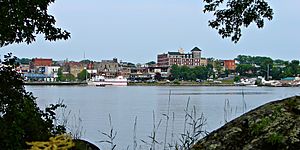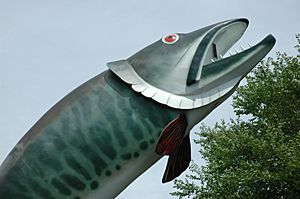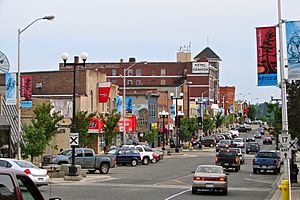Kenora facts for kids
Quick facts for kids
Kenora
|
|
|---|---|
| City of Kenora | |
 |
|
| Country | Canada |
| Province | Ontario |
| District | Kenora |
| Incorporated (town) | 1882 as Rat Portage |
| Renamed | 1905 as Kenora |
| Amalgamated (City) | 2000 |
| Area | |
| • Land | 211.65 km2 (81.72 sq mi) |
| • Urban | 15.25 km2 (5.89 sq mi) |
| Elevation | 409.70 m (1,344.16 ft) |
| Population
(2021)
|
|
| • Total | 14,967 |
| • Density | 70.7/km2 (183/sq mi) |
| • Urban | 10,974 |
| • Urban density | 719.6/km2 (1,864/sq mi) |
| Time zone | UTC−06:00 (CST) |
| • Summer (DST) | UTC−05:00 (CDT) |
| Forward sortation area |
P9N
|
| Area code(s) | 807 |
Kenora is a city in Ontario, Canada. It sits on the beautiful Lake of the Woods, very close to the border of Manitoba. It is about 210 kilometers (130 miles) east of Winnipeg by road. Kenora is the main city of the Kenora District.
The name Kenora comes from combining parts of three nearby towns. These were Keewatin, Norman, and Rat Portage. The original name, Rat Portage, came from the Ojibwe name Wazhashk-Onigam. This means "portage to the country of the muskrats." A portage is a place where you carry boats or goods over land between two bodies of water. The Hudson's Bay Company used this shorter name for their trading post.
In 1905, the town of Rat Portage was officially renamed Kenora. Later, in 2001, Kenora joined with the towns of Keewatin and Norman, and the Township of Jaffray Melick. This created the larger City of Kenora we know today. Kenora is also the main office for several First Nations governments in the area. These include the Anishinabe of Wauzhushk Onigum, Obashkaandagaang Bay, and Washagamis Bay First Nations.
Contents
Exploring Kenora's Past
Early History and European Settlers
Kenora is located on the traditional lands of the Ojibway people. One of the first Europeans to see the Lake of the Woods was Jacques de Noyon in 1688. Later, in 1732, a French explorer and fur trader named Pierre de La Vérendrye built a trading post called Fort Saint Charles. This fort was south of where Kenora is now. France controlled this area until 1763. Then, the British took over after the Seven Years' War.
In 1836, the Hudson's Bay Company set up a trading post on Old Fort Island. By 1861, they moved it to the mainland, where Kenora is today. In 1878, they planned out the town of Rat Portage. The community kept this name until 1905 when it became Kenora.
Boundary Disputes and Growth
For a while, both Manitoba and Ontario claimed Kenora as their own. This argument was called the Ontario-Manitoba boundary dispute. It lasted from 1870 to 1884. Finally, in 1889, it was decided that Kenora would officially be part of Ontario. This helped set the borders between Ontario, Manitoba, and the U.S. state of Minnesota.
Gold and the railway were very important in Kenora's early days. Gold was first found in the area in 1850. By 1893, there were 20 gold mines working near Rat Portage. The first Canadian train to travel across the country passed through in 1886. This was on the Canadian Pacific Railway line.
Later, a highway was built through Kenora in 1932. It became part of Canada's first coast-to-coast highway in 1943. Today, it is part of the Trans-Canada Highway. This means Kenora is on both of Canada's main travel routes. The bridges over the Winnipeg River are very long and special.
During the time of Prohibition in the United States, Lake of the Woods was used by smugglers. They would transport alcohol across the lake.
Community Milestones
In December 1883, a big fire happened in Rat Portage. About 70 people lost their homes.
The Kenora Thistles hockey team won the famous Stanley Cup in 1907. This team had amazing players like Billy McGimsie and Art Ross. Kenora is the smallest town ever to win a major North American sports championship.
In 1965, about 400 Indigenous people marched in Kenora. They were protesting against racism. This event is often called Canada's first civil rights march.
In 1967, Kenora built a large statue called Husky the Muskie. It is a 40-foot (12-meter) statue of a fighting muskellunge fish. It has become a symbol of the town and is very well known.
A bank robbery happened in Kenora on May 10, 1973. An armed man entered the Canadian Imperial Bank of Commerce. He had a device that would explode if he let go of it. Police stopped the robber, and the device exploded. This caused damage to nearby buildings. The robber was never identified.
The logging industry became less important in the late 1900s. The last log boom was brought into Kenora in 1985. Now, tourism and recreation are much more important for the city's economy.
Kenora's Landscape and Weather
Neighborhoods of Kenora
The City of Kenora includes several neighborhoods. These are Norman, Rabbit Lake, Rideout, Pinecrest, Minto, and Lakeside. It also includes the areas that used to be the towns of Keewatin and Jaffray Melick.
Keewatin is on the western side of Kenora. Norman was a small community between Keewatin and Rat Portage. Keewatin was founded in 1877, and Norman in 1892. Both joined with Rat Portage in 1905 to form the Township of Kenora. Keewatin later became its own township in 1908.
Jaffray Melick is in the northeastern part of Kenora. The Township of Jaffray started in 1894, and Melick in 1902. They joined in 1908 and became Jaffray Melick in 1911. Jaffray Melick is more rural than the other areas. It has fewer stores and one golf course.
Climate and Seasons
Kenora has a climate with warm summers and cold, dry winters. This is called a humid continental climate. In winter, the average high temperature in January is about -11°C (12°F). The low is around -21°C (-6°F). Temperatures below -20°C (-4°F) happen about 45 days a year. Kenora gets about 158 centimeters (62 inches) of snow each year. Winters are drier than places further east.
Summers are warm, with a July high of about 24°C (75°F) and a low of 15°C (59°F). Temperatures above 30°C (86°F) happen about 5 days a year. The city gets about 662 millimeters (26 inches) of rain each year. Most of the rain falls in the summer months. June is usually the wettest month, and February is the driest.
Snow usually covers the ground from November to March. This is about 154 days a year. Kenora often has thunderstorms in late spring and summer. These happen about 24 days a year.
The hottest temperature ever recorded in Kenora was 40.6°C (105.1°F) on July 11, 1936. The coldest temperature ever recorded was -43.9°C (-47.0°F) on January 20, 1943.
People and Economy
Population and Diversity
In 2021, Kenora had a population of 14,967 people. The city is home to a diverse group of people. About 21% of the population identifies as Aboriginal. This includes First Nations and Métis people. Most of the population is of European background.
Kenora's Economy
Forestry, tourism, and mining are the three biggest parts of Kenora's economy. The city's population almost doubles in spring and summer. This is when many people who own summer homes come to stay. The Lake of the Woods and other smaller lakes attract these visitors. Many come from nearby Manitoba and the U.S. state of Minnesota.
Tourism and Activities
Kenora is a popular place for visitors from all over the world. In the summer, people come for swimming, biking, fishing, hiking, and boating. Kenora's tourism is also busy in winter. Visitors enjoy ice fishing, snowboarding, skiing, and snowmobiling.
Kenora has two places where visitors can get information. One is the pavilion on the Harbourfront. The other is the Discovery Centre, which opened in 2011. It is open all year round.
Arts, Culture, and Sports
Cultural Attractions
The Lake of the Woods Museum and Douglas Family Art Centre are located together at The MUSE. These places show the history and art of the region.
Harbourfront is a park on the shore of Lake of the Woods. It hosts Kenora's yearly winter and summer festivals. It also has concerts.
Huskie the Muskie, the large fish statue, is in McLeod Park.
The downtown area of Kenora has a public art project. There are 20 murals painted on buildings. These murals show the history of the region.
Kenora also hosts a big international fishing tournament for bass.
St. Alban's Anglican Cathedral is a notable church in Kenora.
Sports History
The Kenora Thistles ice hockey team won the Stanley Cup in 1907. This makes Kenora the smallest city to have ever won this famous trophy. Many local hockey teams today are named after the Thistles.
Getting Around Kenora
Transportation Options
Via Rail offers passenger train service to Redditt. Redditt is about 20 kilometers (12 miles) north of Kenora. The CP train line goes right through Kenora.
The Kenora Airport is about 5 nautical miles (9 kilometers) east-northeast of the city center.
The M.S. Kenora is a cruise boat. It offers tours from the waterfront.
Highway 17 runs through Kenora's main area. The Highway 17A Kenora By-Pass goes around the city. Both of these highways are part of the Trans-Canada Highway. Highway 658 goes north from Kenora to Redditt.
Kenora Transit has three bus routes. They run from Monday to Saturday, from 7:00 AM to 6:30 PM.
Education in Kenora
Kenora has two school boards and a college.
The Keewatin-Patricia District School Board runs one high school, Beaver Brae Secondary School. It also has four elementary schools: Keewatin Public School, Evergreen School, King George IV School, and Valleyview School.
The Kenora Catholic District School Board has one high school, Saint Thomas Aquinas High School. It also has three elementary schools: École Ste. Marguerite-Bourgeois, Pope John Paul II School, and St. Louis School. École Ste. Marguerite-Bourgeois is a French immersion school.
Confederation College has a campus in Kenora. It offers programs for college students and adults.
Inside the college is Contact North. This allows Kenora residents to access university and college programs online. These programs might not be offered directly by the local campus. Contact North helps people in remote parts of Northern Ontario get an education.
There is also an Indigenous college called Seven Generations Education Institute. It helps Indigenous and non-Indigenous students prepare for jobs in the area.
Geological Significance
One of Earth's earliest supercontinents is named Kenorland. This huge landmass existed about 2.72 billion years ago. It was named after the Kenoran orogeny, a mountain-building event. This event was named after the town of Kenora, Ontario. Scientists have found rocks and magnetic evidence in Kenora that support the idea of Kenorland forming a very long time ago. This makes Kenora important in understanding Earth's very early history.
News and Radio
The main newspaper in Kenora is the Kenora Miner and News.
Radio Stations
- FM 89.5 - CJRL-FM ("89.5 The Lake"), plays adult contemporary music.
- FM 93.5 - CKSB-7-FM, a French-language station from Winnipeg.
- FM 98.7 - CBQX-FM, a CBC Radio One station from Thunder Bay.
- FM 101.3 - CKWO-FM, a First Nations community radio station.
- FM 104.5 - CKQV-FM-2 ("Q104"), plays hot adult contemporary music from Vermilion Bay.
Famous People from Kenora
- Gary Bergman, former NHL player
- Glory Annen Clibbery, actress
- Ralph Connor, writer
- Tim Coulis, former NHL player
- Abigail Dent, Olympic silver medalist in rowing
- Phil Eyler, politician
- Silas Griffis, Hockey Hall of Famer
- Peter Heenan, politician
- Robert Hilles, poet
- Tom Hooper, Hockey Hall of Famer
- Wab Kinew, Premier of Manitoba
- Kyle Koch, former CFL player
- Victor Lindquist, Olympic hockey gold medalist
- Shane Lunny, designer and producer
- Eric Melillo, Member of Parliament
- Bob Nault, former Member of Parliament
- Dennis Olson, ice hockey player
- Tom Phillips, Hockey Hall of Famer
- Mike Richards, ice hockey player
- Greg Rickford, politician
- Rick St. Croix, former NHL goaltender
- Jacques Schyrgens, painter
- Mike Smith, silver medalist in decathlon
Images for kids
See also
 In Spanish: Kenora (Ontario) para niños
In Spanish: Kenora (Ontario) para niños






